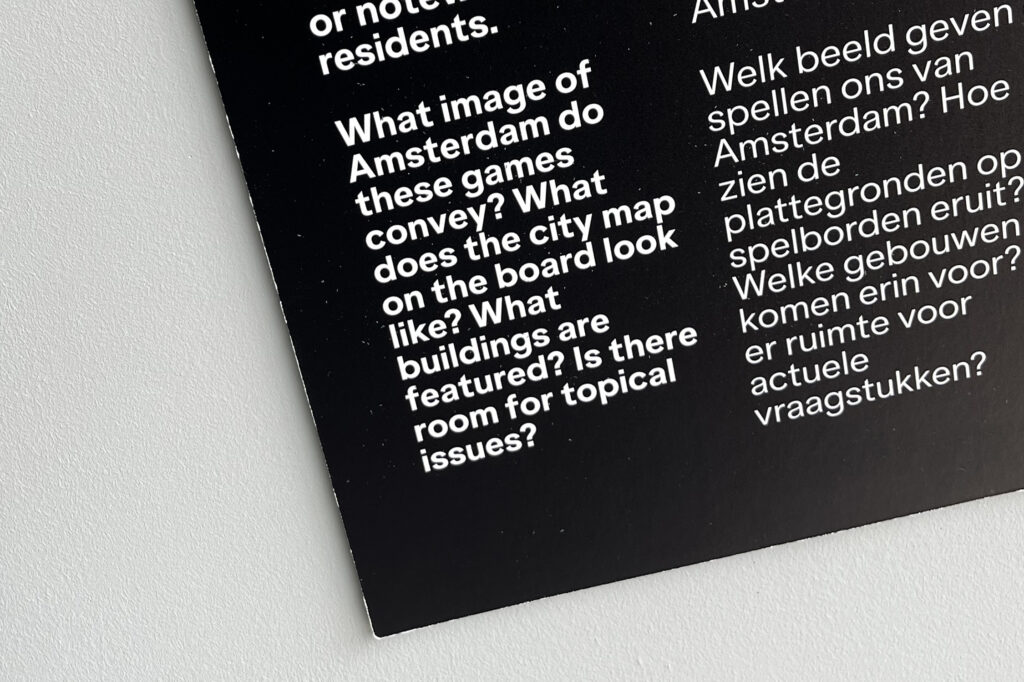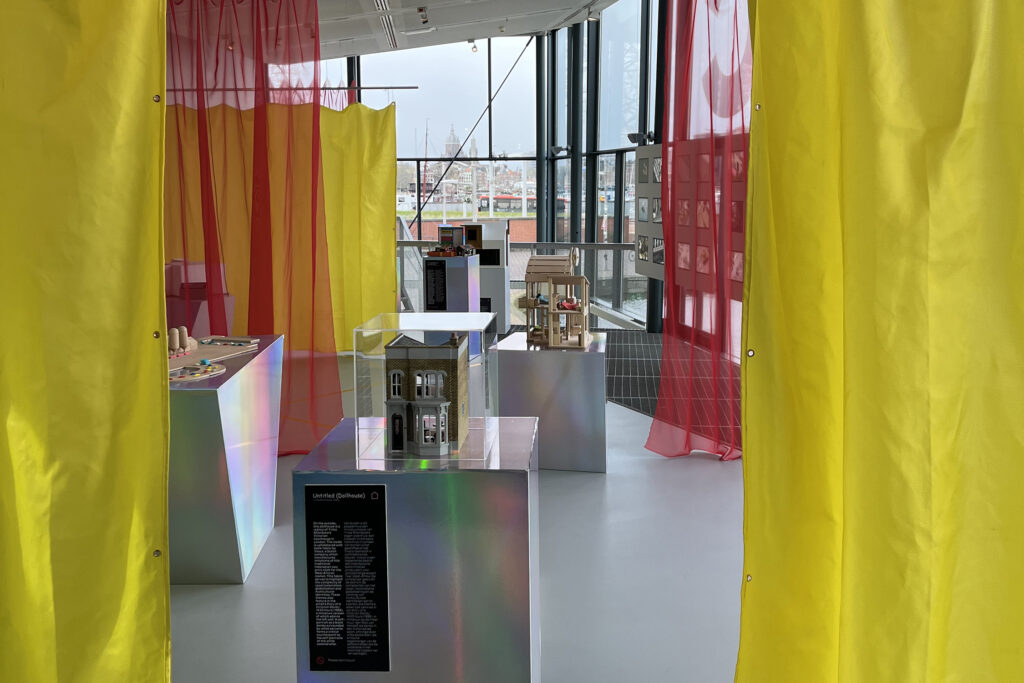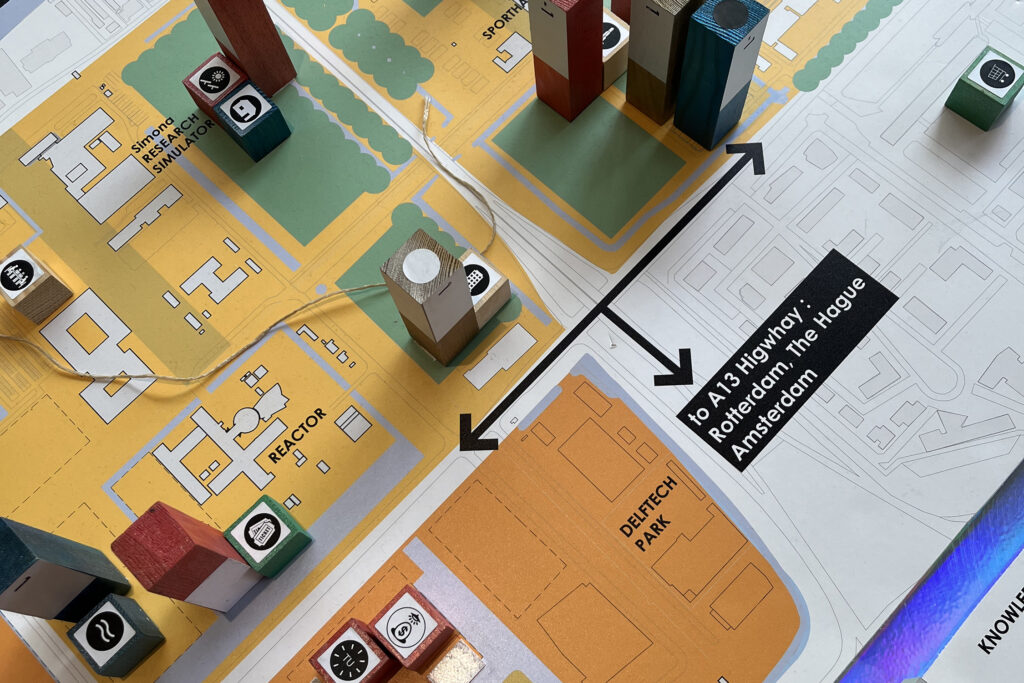12/22 – 05/23 Amsterdam, NL
‘Playing Architecture – the City in Play’ is an exhibition intended to engage audiences through experiencing play, based on a range of analogue and digital games – with an architecural focus, and is part of an ongoing programme of exhibitions at ARCAM focussed on matters of the built environment.

Curated by cultural anthropologist and author, Mélanie van der Hoorn, the exhibition also asks questions of its visitors (image 1), such as ‘What image of Amsterdam do these games convey?’ and ‘What role does architecture play in these virtual worlds?’. Alongside van der Hoorn’s interest in board games and their cross-overs with architecture, the exhibition is also guided by the architect Dafne Wiegeers of AHH, who brings a deep interest in digital games and their influence on real-world design. The combined approach brings a varied range of content, from dolls houses to 3D models, and from board games to digital interactive games.
The layout design of the exhibition follows convention with a fixed route through the space, leading visitors through six zones with specific themes, with examples ranging from ‘Reviled Architecture’ to ‘Playing in Practice’. Although the diligent observer can distinguish between the zones, lesser-engaged visitors may overlook the nuanced thematic changes. This is, in part, due to the small-scale footprint of the host building, but alleviated slightly by brightly-coloured fabric screens suspended in the space, which suggest transitions between the zones (image 2).



Within the limited space, a wide range of means are employed to visually and physically engage visitors – text panels, floor graphics, and a diverse mix of content displayed on angular plinths wrapped in reflective surfaces. The playful interior environment is foreground to a backdrop of Piano’s envisioned view across the river (see footnote), adding a strong sense of place. The riverside location is certainly a strength of the venue, which unlike many does not benefit from an on-site café. There is, however, a space for selling books and periodicals, with those most topical to the exhibition prominently displayed.
Engagement is a key aim of the exhibition, which has play as the central theme. The exhibition asks questions of visitors, but does not ask for answers – leaving space for questions to be considered. This, as a tactic, could be agreeable to some visitors, but does miss the opportunity to gather reactions and insight to visitors’ views.
Amongst the content, interesting and innovative artefacts appear, such as Delft Campus Urban Game – a large 3D plan in the form of a board game, populated by movable wooden blocks that represent buildings typologies and zones (image 3). Devised by Rotterdam-based practice Blok74, the model uses gameplay to engage a cross-section of stakeholders in the process of planning – within a structured workshop scenario. As a stand-alone artefact, the ‘boardgame’ is visually appealing (and sheds light on a novel method of engagement), although outside of the context of a workshop setting, is a static object.
Conversely, for an exhibition centred on play, the level of hands-on engagement is low; visitors generally move through the space in a passive manner, occasionally stopping to read or look closer at an object. Since introducing a building entry fee in June 22, the venue reports less footfall than during free entry (although it is still modest at 4 Euros).
However, where this particular exhibition falls short on hands-on engagement, the organisation stands as an exemplar in connecting communities to urban and architectural matters. They achieve this through a strong online presence, with a well-designed and highly interactive website , and through ongoing events and initiatives.
Audience engagement manager at ARCAM, Femke Gerritsma, highlights the term ‘Co-Pro’ in relation to ARCAM; ‘…to be a bridge between the community and the pros’ collecting feedback, undertaking research and developing advice which can be fed back to professionals who have the power to act and make changes.
A successful example of another in initiative ARCAM are involved with is ‘Subjective Atlas of the City’, which maps voices and experiences (through drawings and visuals) from around Amsterdam, focussing on groups who are deemed to be underrepresented in the architectural discourse. Their targets for the shared knowledge are policymakers, architects and city planners – having already involved social housing corporation, Ymere. The project is long-running, and organises workshops for such engagement, culminating in exhibitions and research outputs. Gerritsma points towards plans to make exhibitions that are aimed more squarely at engaging audiences with future urban developments, seeking to involve communities in projects early on to develop insight and feedback.
‘Playing Architecture’ could be more engaging as an exhibition, although there are always to be challenges in tackling a niche subject. The design of the exhibition could perhaps have explored more ways to prompt hand-on interaction, and ways to introduce methods and devices that act as a feedback loop for audience engagement.
Considering the question of whether such exhibitions have the potential to affect change within the built environment, in the case of ARCAM, it is their wider programme which goes a long way to make this possible. Gerritsma does not lose sight of the importance of their role, reflecting on the position of their institution within the context of the wider city; ‘..the real architecture is outside, that is our collection’.
Exhibition review: B. Couture & T. Ahmed, 2023
Footnote: About the host building
ARCAM (Amsterdam Centre of Architecture) is situated in a small, aluminium-clad pavilion on the riverside in central Amsterdam. Since inception in 1986, the organisation has played an active role in linking local architecture, urban design and landscape design with the Dutch community.
Their home is set over three-floors, in a structure originally designed as a viewing platform and pavilion by Renzo Piano – directing views over the river towards the NEMO (National Centre for Science and Technology), 1997. Destined for demolition, local architect René Van Zuuk reimagined the building in 2003, making use of the existing steel structure, in a new design that provides both workspace for ARCAM, and a destination venue for architectural exhibitions and events.